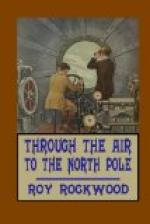This lower part, as the boys could see, was just like a steam launch in shape, only much lighter in weight. It had a sharp bow, and a blunt stern. From the stern there extended a large propeller, the blades being made from sheets of aluminum.
The main part of the ship proper, or the part suspended from the gas bag, was covered by a closed and roofed cabin about forty feet long, ten feet wide, and extending five feet above the gunwale of the ship. The cabin had four windows on each side, a companionway fore and aft, and a sort of look-out or conning tower forward, which, the professor explained, was the place for the steersman.
“Because this ship can be steered wherever you want to go,” he said, pointing to the big rudder that was hung aft, an opening in it allowing the screw or propeller to revolve.
The boys were lost in admiration of the wonderful airship. They were consumed with curiosity as to how the machinery worked, and they thought no more of their knocks and bruises than as if a mosquito had bitten them. The professor watched their faces with delight. He loved boys and mechanical apparatus.
“Now we will enter the Monarch,” he said. “Turn on the lights, Washington.”
There was a click, and the cabin of the airship was flooded with a soft glow of incandescent lamps.
“Come on!” called Mr. Henderson, leading the way. The boys followed, marveling at the wonders on every side.
They found the cabin of the strange craft divided into three parts. First came a sort of parlor, with a table and seats arranged on the sides. In the front part of this was a passage leading to the conning tower, or the place for the steersman. Behind the parlor came the sleeping quarters and dining room combined. The bunks were arranged to fold against the wall, and a table in the centre could be shut up when not in use and hoisted to the ceiling, giving plenty of space.
Next came the engine room, and as they entered it the boys could hardly restrain from giving cheers of delight. It was almost filled with machinery, and occupied a little more than half of the whole boat, being twenty-two by ten feet in size.
The two boys did not know the use of one quarter of the machinery and apparatus they gazed on. There were electric motors, storage batteries, two gasoline engines similar to those used in automobiles, pumps, large and small tanks, instruments for measuring the electric current, for telling the temperature, the amount of moisture in the air, the speed of the wind, the speed of the ship, the height to which it went, besides compasses, barometers, telescopes, and other instruments.
There were levers and wheels on every side, switches, valves, electric plugs and handles. Lockers arranged close to the wall and along the floor held supplies and materials. Everything was new and shining, and the professor smiled with pride as he touched piece after piece of machinery, and looked at the different instruments.




